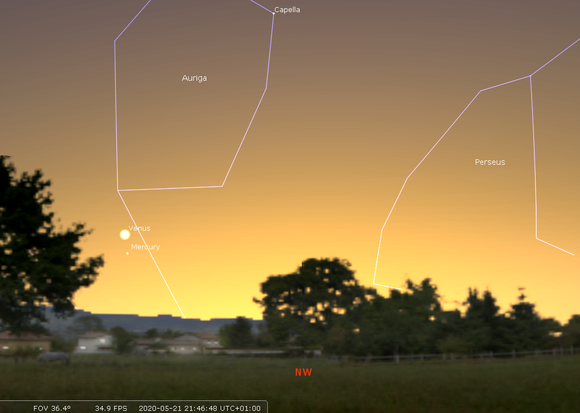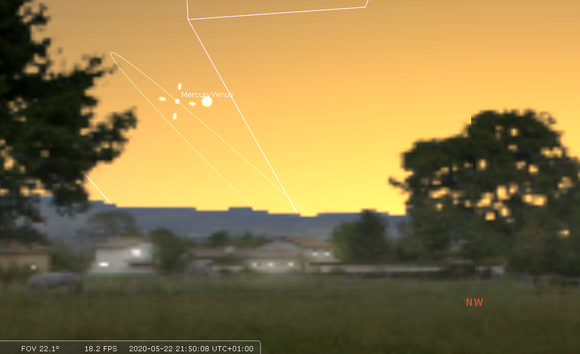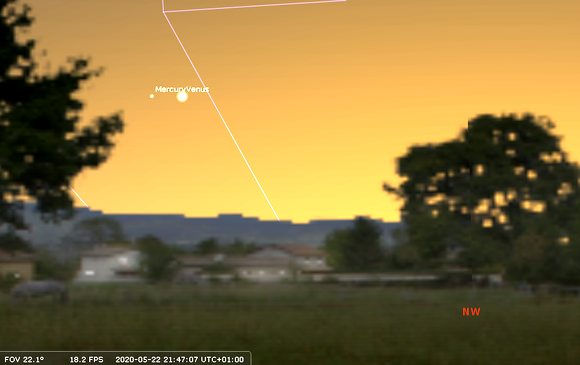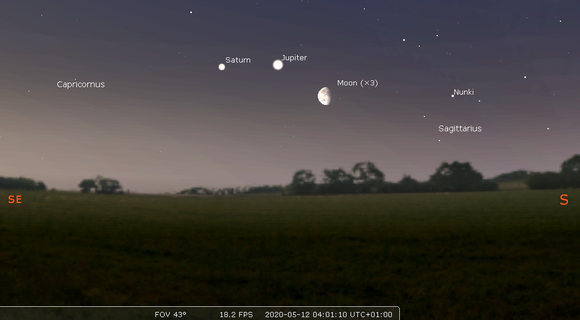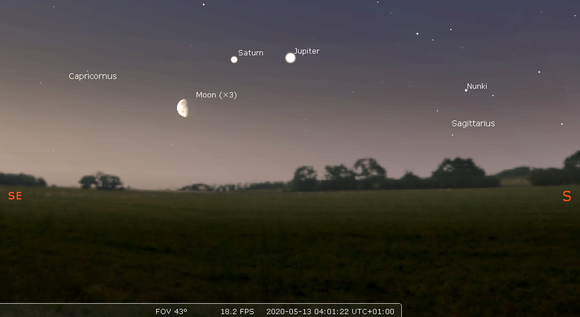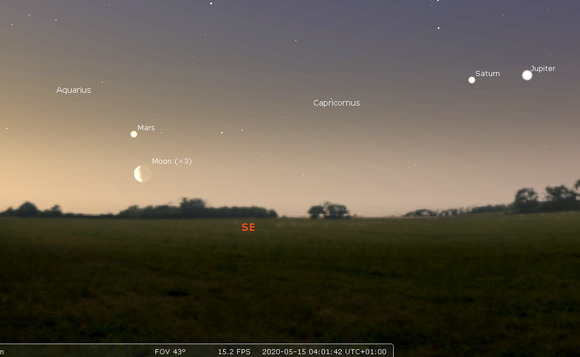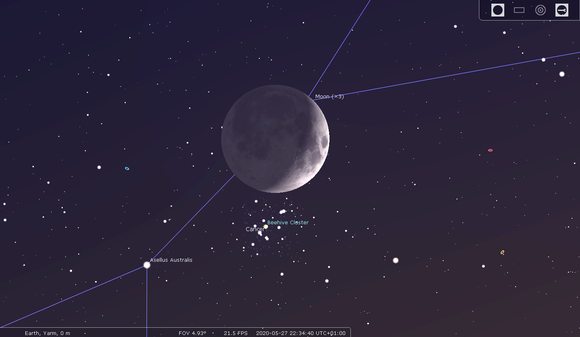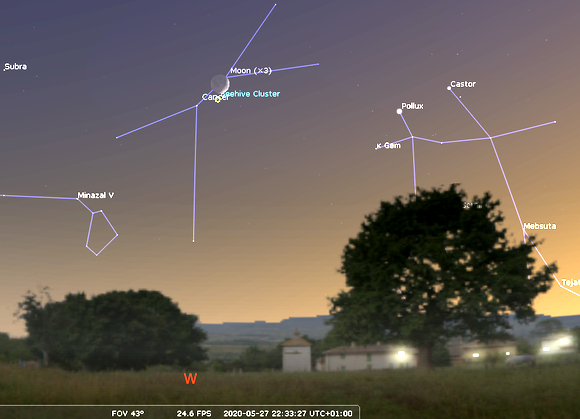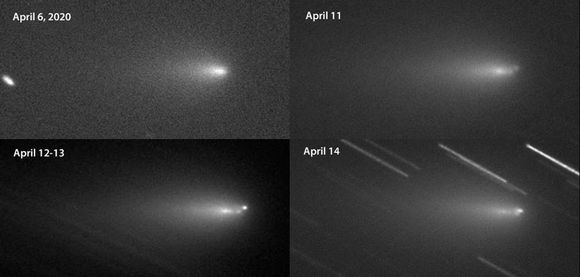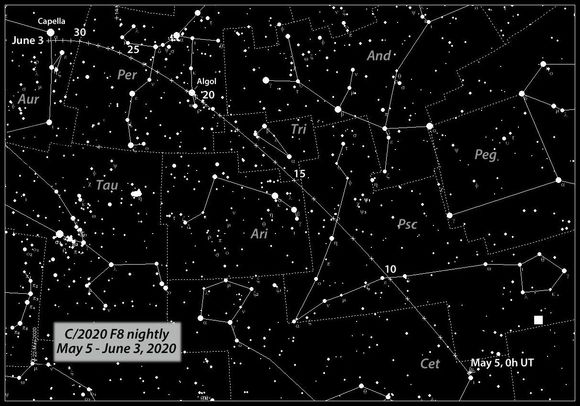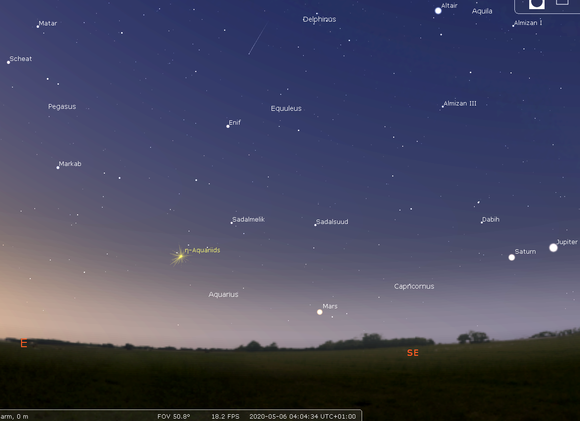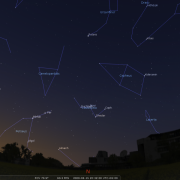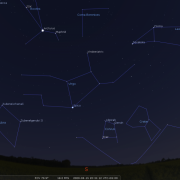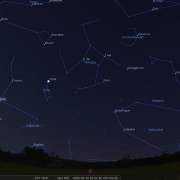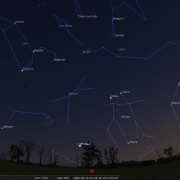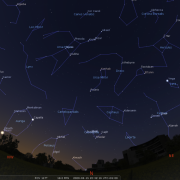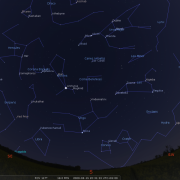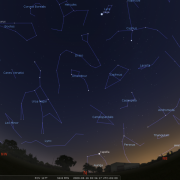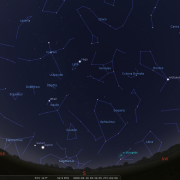In this month's Sky Notes:
Planetary Skylights
Evening Planets
 Venus remains the most conspicuous object in the western twilight sky. May is, however, the final month in which to observe the ‘evening star’ as it will rapidly drop back toward the horizon and by the month’s end is lost in solar glare. Before departing it is involved in one last planetary conjunction, meeting Mercury coming the other way.
Venus remains the most conspicuous object in the western twilight sky. May is, however, the final month in which to observe the ‘evening star’ as it will rapidly drop back toward the horizon and by the month’s end is lost in solar glare. Before departing it is involved in one last planetary conjunction, meeting Mercury coming the other way.
 Look for this second ‘star’ moving upwards from WNW horizon from the 20th onwards. The ‘star’ in question; Mercury will have an evening apparition lasting into early June. The two planets lie side by side on May 22nd, with Venus on the left. If you cannot spot Mercury with the naked eye initially, use a pair of binoculars to pick it out of the twilight. Mercury will appear brightest at the start of its apparition (always the case for evening apparitions) so view during the final 10 days of May. On the 24th a very thin Crescent Moon lies off to the left of both planets. This will be a good test of observing skills and timing to spot them. Wait to observe around 45minutes after sunset looking not far above the WNW horizon.
Look for this second ‘star’ moving upwards from WNW horizon from the 20th onwards. The ‘star’ in question; Mercury will have an evening apparition lasting into early June. The two planets lie side by side on May 22nd, with Venus on the left. If you cannot spot Mercury with the naked eye initially, use a pair of binoculars to pick it out of the twilight. Mercury will appear brightest at the start of its apparition (always the case for evening apparitions) so view during the final 10 days of May. On the 24th a very thin Crescent Moon lies off to the left of both planets. This will be a good test of observing skills and timing to spot them. Wait to observe around 45minutes after sunset looking not far above the WNW horizon.
Early Dawn
The early dawn sky is home to Jupiter, Saturn and Mars, which all reside low to the South-East.


 Jupiter and Saturn lie pretty close together in the SSE, with more conspicuous Jupiter on the right. Although low in the sky, both planets will stand telescopic observations, but patience will be required at the eyepiece for those steady moments of seeing. Look for the banding features across Jupiter’s disk – perhaps the great red spot and the Galilean moons. Saturn’s rings will be visible in even small scopes, but detail will be elusive given the low altitude. A waning Crescent Moon passes by Jupiter and Saturn on May 12 & 13th.
Jupiter and Saturn lie pretty close together in the SSE, with more conspicuous Jupiter on the right. Although low in the sky, both planets will stand telescopic observations, but patience will be required at the eyepiece for those steady moments of seeing. Look for the banding features across Jupiter’s disk – perhaps the great red spot and the Galilean moons. Saturn’s rings will be visible in even small scopes, but detail will be elusive given the low altitude. A waning Crescent Moon passes by Jupiter and Saturn on May 12 & 13th.
 Mars spends May dashing away from Jupiter and Saturn towards the ESE. The red planet has a distinct orange hue and although is not as bright as Jupiter is nevertheless still quite conspicuous. Telescopically, Mars remains diminutive in the eyepiece with surface detail still rather difficult to make out in most amateur scopes.
Mars spends May dashing away from Jupiter and Saturn towards the ESE. The red planet has a distinct orange hue and although is not as bright as Jupiter is nevertheless still quite conspicuous. Telescopically, Mars remains diminutive in the eyepiece with surface detail still rather difficult to make out in most amateur scopes.
The downside with observing these morning planets is the awkward timing, an observer having to be up around 03:30-04:00h to appreciate them. The moon resides below Mars on the 15th.
Finally keep an eye out on the 27th when a waxing crescent moon buzzes the Beehive cluster (M44) in Cancer. The Moon will pass just a fraction above the star cluster. View around 22:30h.
Comets
Comet 2019Y4 (ATLAS)
It was hoped that a comet would unexpectedly grace our skies this month. The comet in question Comet 2019 Y4 (ATLAS) was discovered by the Asteroid Terrestrial impact Last Alert System, based in Hawaii, last December shining at a barely scientific newsworthy magnitude of +19. During February and March however Atlas brightened incredibly rapidly, reaching +6.8 by late March.
Now, as all amateur astronomers know predicting the brightness of a comet is like nailing jelly to a wall whilst riding a horse in the grand national (virtual horse of course) If the comet had continued to brighten at the same rate, bearing in mind it was not due to reach perihelion until the end of May, estimates for the comet’s brightness at this time ranged from an impressive magnitude -5, (in which case the comet would be visible in the bright twilight evening sky) to +2, still quite respectable.
Well, all of the above was initially penned in hope a couple of weeks ago, since then the ‘jelly’ has hit the floor and Comet Atlas has fragmented into several pieces and very likely to disintegrate into obscurity as it heads closer to the Sun............but
06-14th April 2020: Comet 2019Y4 (ATLAS) before and after breaking apart.
(Click for full-sized image)
Comet C/2020 F8 SWAN
But hold on a minute, another comet has suddenly popped up on the radar, just as comet Atlas began to fall apart.
Comet C/2020 F8 Finder Chart (Credit: theskylive.com). (Click for full-sized image)
Comet Swan (C/2020 F8) was discovered from data from NASA's Solar and Heliospheric Observatory (SOHO), it was spotted with SOHO's Solar Wind ANisotropies instrument (SWAN) even though it wasn't designed to find comets, but hydrogen.
The comet is small (like ATLAS) and is unlikely to be ‘eye catching’, but you never know with comets, ‘like cats they have tails and usually do what they want’.
Comet Swan will make its closest pass to Earth on May 12, coming within 51.7 million miles, before reaching its closest point to the sun, perihelion, on May 27th. Currently comet Swan resides South of the equator in the constellation of Sculptor, but it is heading northwards and if it continues to brighten at its present pace, it could then become visible to the naked eye from our latitude from the 22nd onwards. Comet Swan will then be passing up through the upper left hand side of Perseus heading toward bright Capella in Auriga for early June. You will need to view low in the NNW sky around 22:45h and/or low in the NNE around 03:00h. It is unfortunately the brightest part of the sky at this time of year.
As of going to press a cautionary note has to be struck as the latest data /images suggest like Comet Atlas, comet Swan may also disintegrate and fade. Comets ...do my head in!
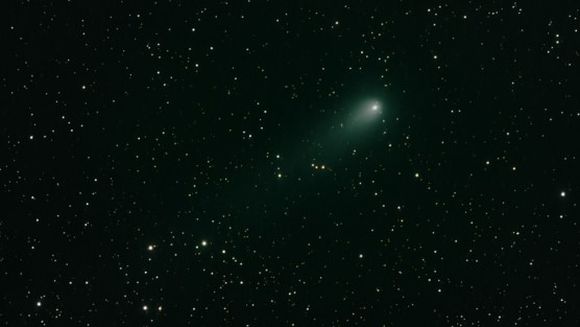
Meteors

If you are a very early riser, look out for some shooting stars around May 5/6/7th, when the Eta Aquarid meteor shower reaches a peak.
The shower actually peaks on the evening of the 5th, but as Aquarius rises in the early morning hours at this time of year, the morning of the 6th will be the optimum time to view. Observations will be somewhat hampered by light from a waxing Moon, being just two days off Full, it will however be dropping lower into the west by that time.
This is one of two meteor showers associated with debris particles deposited over time by comet Halley, the other shower being the Orionids seen in late October.
Eta Aquarids have a ZHR (zenith hourly rate) approaching 30, conditions this year will restrict numbers to perhaps 9-12 per hour. The radiant of the shower lies close to eta Aquarius, one of the stars making up the "water jar" in the otherwise faint constellation of Aquarius. View around 04:00h to the South, East or higher to the Southeast.
|
Looking North
Mid-May - 22:30h |
Looking South |
|
Looking East
Mid-May - 22:30h |
Looking West
Mid-May - 22:30h |
|
Northern Aspect
Mid-May - 22:30h |
Southern Aspect
Mid-May - 22:30h |
|
Looking North (Early)
Mid-May - 03:30h |
Looking South (Early)
Mid-May - 03:30h |
Additional Image Credits:
- Planets and Comets where not otherwise mentioned: NASA
- Sky Charts: Stellarium Software
- Log in to post comments

